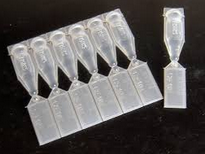Bacterial Conjunctivitis
Chloramphenicol €“ comes in two formulations, eye drops and ointment.
These treatments are licensed for adults and children from the age of two years old, but are not suitable for pregnant, breastfeeding women or customers who have a family history of blood dyscrasias (such as leukaemia, haemophilia or other blood cell abnormality). Customers who wear contact lenses should not be supplied with chloramphenicol treatments over the counter, they should be referred to their GP. Customers who have been diagnosed with other eye conditions such as glaucoma or dry eye syndrome should be referred to the pharmacist.

Propamidine isethionate €“ These treatments are licensed for adults and children but ensure you refer to the manufacturer's guidelines for full information. If a customer's symptoms do not improve or worsen after two days of applying the treatment, they should be referred to the pharmacist.
Allergic Conjunctivitis
Lodoxamide €“this is found in antihistamine eye drops. It can help to relieve the symptoms of inflammation, redness, itchiness or watering with few side effects. Customers should be advised that they may experience some initial discomfort on application of the drops, but this will decline as the condition improves. The drops can relieve symptoms quickly with benefits seen within a few days, although longer treatment is often required. Lodoxamide must not be used for more than four weeks.
Sodium cromoglycate €“ Sodium cromoglycate is a mast cell stabiliser which prevents the release of histamine and other allergic mediators from the mast cells. It is effective and relatively free from side effects. The manufacturers' guidelines for each product must be referred to for guidance as to who can safely use the product and a suitable dose to recommend. Cromoglycate based treatments will not provide rapid relief but are more effective at controlling symptoms over a longer period of time, if used frequently as a preventative measure.
Combination anti-allergy drops (antazoline and xylometazoline) €“ these products include antazoline acting as an antihistamine and xylometazoline as a vasoconstrictor. The antihistamine acts to relieve the allergic symptoms, whilst the vasoconstrictor narrows the tiny blood vessels in the surface of the eye to stop them from carrying chemicals that generate the allergic symptoms. The vasoconstrictor action will also help to relieve the red blood shot appearance of the eye. These combination drops are not suitable for everyone, such as children under 12 years, contact lens wearers and customers with raised pressure in the eye (glaucoma) and should not be used for longer than seven days.
Oral antihistamines €“ Commonly found in hay-fever treatments may also provide relief from symptoms. They can be useful if a customer has other allergy symptoms to manage. Familiarise yourself with the antihistamine products that you stock and refer to the packaging or product information leaflets for details of age groups and doses when recommending them to customers.
